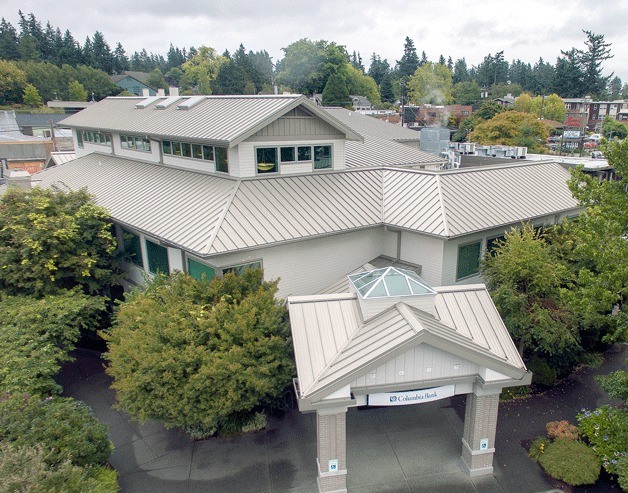An iconic Winslow Way bank building has been purchased for $3.65 million.
Local businessman George Lobisser bought the 20,000-square-foot building from Columbia State Bank of Tacoma on Aug. 22.
The bank will continue to lease its 4,000-square-foot branch under a 20-year lease, while Lobisser will move his small startup into the building and look for other tenants.
Lobisser, a longtime Seattle commuter, said that after 37 years of living on the island, he was eager to invest in the place he calls home.
He considered purchasing the San Juan Building, near the Bainbridge ferry terminal, but another buyer beat him to it. So Windermere broker Kelly Muldrow offered Lobisser something better.
It just wasn’t for sale yet.
The building, long an anchor on the city’s main drag, has a relatively long history.
Bainbridge Island Bank opened Sept. 17, 1948 in a “modernistic structure, built of concrete blocks,” according to the Bainbridge Review story announcing its arrival. Local investors pooled together $25,000 for the launch, with 84 accounts — 37 checking, 47 savings — opened on its inaugural Friday.
By 1970, rapid expansion and the opening of several regional branches had necessitated a name change, according to the Review. Bainbridge Island Bank became American Marine Bank to appease both founding president Louis Goller and his wife Gloria. (Louis favored a name close to the beginning of the alphabet, while Gloria thought a maritime connotation was indispensable.)
The island institution, which for 61 years served Bainbridge’s finest, from the owners of Town & Country to Winslow Hardware, was closed by state regulators in 2010 because of inadequate capital and severe loan losses.
 Almost immediately, Columbia Bank took over AMB’s 11 branches and its airy island headquarters, which had just undergone an expansive two-year reconstruction six years earlier, complete with wood banisters and a three-story atrium.
Almost immediately, Columbia Bank took over AMB’s 11 branches and its airy island headquarters, which had just undergone an expansive two-year reconstruction six years earlier, complete with wood banisters and a three-story atrium.
Though the building was not for sale, Muldrow realized he might be able to broker a deal this spring while having lunch with a bank employee.
“He talked about how his office was being relocated up into the retail area and it seemed obvious that [Columbia Bank] was vacating about 15,000 square feet,” Muldrow explained.
“It just occurred to me that owning a building with 15,000 square feet of really nice vacant space wasn’t the best thing for the bank.”
There was just one problem: the building was empty.
In the Kitsap market, investors aren’t typically in the mood to buy investments that aren’t already performing, Muldrow said.
But Lobisser was unique. He actually preferred this arrangement.
“I said, ‘Kelly, trust me; I’d rather have a fundamentally empty great piece of real estate than a fully occupied building that can lose its tenants tomorrow,’” Lobisser recalled saying.
After all, there was much to love.
Besides the beautiful construction, the building has a primo location and 70 parking stalls.
“It’s a jewel,” Lobisser said.
Ideally, he’d like to find a large single tenant, since that’s what the building was designed for, but if necessary, Lobisser will divvy up the space for multiple tenants.
Either way, he’s not in any rush.
“How you tenant a building is important,” Lobisser said. “I want to take my time and do it right.”
He did have one idea for a potential renter, a proposal that will definitely stir the pot.
“You know what that building could be great for? The police station and courthouse,” he said.
It’s the right size (Lobisser pointed out multiple areas that could be expanded to accommodate a 21,500-square-foot public safety building); it has great security; it has a separate entrance.
“And [the city could get it for] a cost of about 50 percent of what they’re kicking around!” Lobisser exclaimed.
But Muldrow’s insight topped it all.
“We could repurpose the vault into a jail,” he joked.


